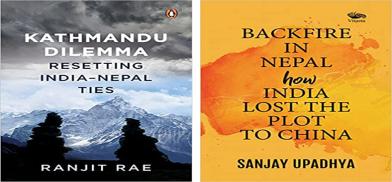India’s Nepal conundrum amid a lengthening Chinese shadow
China’s arrival in South Asia has altered the region’s centre of gravity – a shift that will have lasting reverberations on Nepal and its ties with India

There could not have been a more honest book than Ranjit Rae’s on relations between India and Nepal, where New Delhi is rapidly losing its former influence while Beijing is becoming a bigger and more important political, diplomatic and economic player. According to the former Indian ambassador to Nepal, a lot of this is due to India’s own making though Kathmandu’s political leadership is also to blame. This candidness may upset the rabid nationalists in India, which now faces not only an aggressive China on its border but a steadily lengthening Chinese shadow all across South Asia.
Nepal, Rae tells us, has changed; it is no longer content to be a part of the Indian security umbrella. It wants out from what it perceives to be a claustrophobic Indian embrace. Issues of culture, religion and ties of kinship – which many in India consider major factors in bilateral relationship – are seen as of secondary importance by Nepal’s leadership, particularly the communists. Indeed, for some Nepalese, China is the only economic game in town. This is a harsh reality; it is high time Indians of all hues accept this with grace.
Rae wants India to respect Nepal’s desire for greater political space and an independent foreign policy. New Delhi should not view every agreement Nepal reaches with China as adversely impacting Indian security. The 1950 India-Nepal treaty can be amended a la the revised Bhutan treaty. The old foundations for India’s ties with Nepal may be important but are no longer sufficient.
As the bigger country, it is for New Delhi to create conditions by which Nepal and other neighbours benefit from India’s growth story. But India cannot use on foreign soil the methods it employs to execute domestic projects. Project delivery has to show substantial improvement; global standards and more pragmatic systems must come in. Otherwise, the complaint will remain: India promises, China delivers.
India must also give up the shibboleths of the past and go for trilateral cooperation and quadrilateral projects. India should view such possibilities more strategically. Indian NGOs must be allowed to work in countries like Nepal by lifting the restrictive policies on transfer of funds from India. India must speak both to the government and the people of Nepal. A peaceful, stable, prosperous and democratic Nepal is in India’s own interests.
If India has to win hearts in Nepal, one of the first things it should do is to dramatically better the infrastructure on its border. “Travelling to India from the Nepalese Terai is a nightmare. It is like going from a first world country with excellent infrastructure to a third world country… The tourist probably receives the shock of his/her life seeing the border condition: teeming crowds, poor sanitation facilities, garbage strewn in no man’s land and lack of clean, hygienic places to eat.”
As far as China is concerned, it has decided to invest more time and money in its relationship with Nepal. It is also intervening in its internal political affairs, and openly. Beijing feels a unified communist force in Nepal is in its strategic interest. Naturally, the China card is an effective instrument Nepal leverages vis-à-vis India.
The widespread impression in Nepal that the Modi regime covertly backed a crippling road blockade over a row over the constitution pushed Kathmandu into China’s embrace like never before. This has led to a deepening convergence of interests between Nepal and China, so much so that Kathmandu doesn’t mind taking on India even amidst worsening Sino-Indian ties. This would have been unthinkable in the past.
Rae, however, points out that China is not loved, it is feared. In that sense, India has certain comparative advantage in her soft power. India’s USP is its democracy, celebration of diversity and culture. This should be used smartly. Nepal and other countries look to Indian democracy and rule of law as well as pluralism. India must pursue policies, even domestically, that becomes a magnet for neighbours.
While Lumbini, the birthplace of Lord Buddha, has monasteries belonging to different countries, India has none. This is a perfect example of failing on the soft power front. The situation in Nepal now is such that irrespective of whatever India does, like for instance helping during the 2015 earthquake, Nepalese take objection to the slightest sign of a Big Brother conduct, leading to tragic consequences on bilateral relations. This often confounds many in India.
No wonder, a perplexed Prime Minister Narendra Modi asked Rae after the quake: “Why don’t they like us?” Rae’s book provides most answers.
Nepalese author and analyst Sanjay Upadhya says India may have thought, correctly at a certain juncture, that it was best suited to stitch together a common political alliance to take on and, if needed, oust the monarchy in Nepal. But it was impudent on the part of New Delhi to trust the leaders of Maoists whose cadres were raised on a staple of anti-India rhetoric. In the process, India paid a huge price even as the monarchy crumbled and Nepal became a republican democracy. Successive regimes warmed up to China. New Delhi was partly to blame for the mess.
A Fulbright Scholar who specializes on his country’s politics and foreign policy, Upadhya weaves an eminently readable account of the ups and downs that New Delhi faced in the landlocked Himalayan nation. The book is important also because it gives a seemingly unbiased Nepalese perspective. Some Indian officials may have considered the erosion of its influence temporary and reversible in the long run. “But the run kept getting longer.”
If authoritarianism in Nepal has thrived on anti-Indianism, democracy has done more to fan the flames, the author says, citing both the 1951-60 and 1990-2002 periods. Indian assertions that it is not a Big Brother and has always helped and aided Nepal does not cut too much ice in the country. There are Nepalese who allege that for every rupee India has given Nepal, it has taken back Rs 771 in unfair advantage in trade and water resources. Whether Indians like it or not, New Delhi must contend with hardening Nepalese sentiments.
Like Rae, Upadhya contends that the temptation to see the India-Nepal row as a Chinese-inspired ploy to weaken New Delhi is not only misguided but a misreading of reality, given that Kathmandu’s own relationship with Beijing is not free from suspicion. The Chinese may not sound so vociferous about it but Beijing too accuses Kathmandu of flaunting the ‘India card’. Upadhya asks: “At what point does being pro-Nepal start becoming anti-Indian?”
The author argues, again like Rae, that China’s arrival in South Asia has altered the region’s centre of gravity – a shift that will have lasting reverberations on Nepal and its ties with India. India’s realization of its inability to compete with China in financial terms is a recognition that the rivalry in South Asia will persist. Upadhya argues that New Delhi’s rough diplomatic intervention in Nepal’s constitutional row and its informal economic blockade pushed Kathmandu into Beijing’s eager arms on a scale never seen earlier. For the first time, Nepal sought fuel shipments from China, ending India’s monopoly in the area.
Just as India cannot apologize for being big, Nepal must not be expected to pay the price for being small and sandwiched between two giants that distrust each other. If New Delhi expects Kathmandu to remain sensitive to its security concerns, Nepal sees this expectation as an infringement on its sovereignty and independence.
But all is not lost in Nepal-India relations, the book says. The tremendous progress India has made in IT has inspired younger Nepalese. Nepal’s strengths – low-cost locations, cheap labour cost and easily trainable workforce – have created room for greater bilateral cooperation. Nepalese are also making slow but steady inroads in Bollywood, literature and sports. Not every Nepalese is happy with strident anti-Indianism. Many would like to play a bridge between China and India. But a vibrant relationship would require Nepal and India to shun their traditional mindset.
Title: Kathmandu Dilemma: Resetting India-Nepal Ties; Author: Ranjit Rae; Publisher: Vintage/Penguin Random House; Pages: 237; Price: Rs 499
Title: Backfire in Nepal: How India Lost the Plot to China; Author: Sanjay Upadhya; Publishers: Vitasta; Pages: 275; Price: Rs 495
(The reviewer is a veteran journalist and South Asia watcher)










Post a Comment